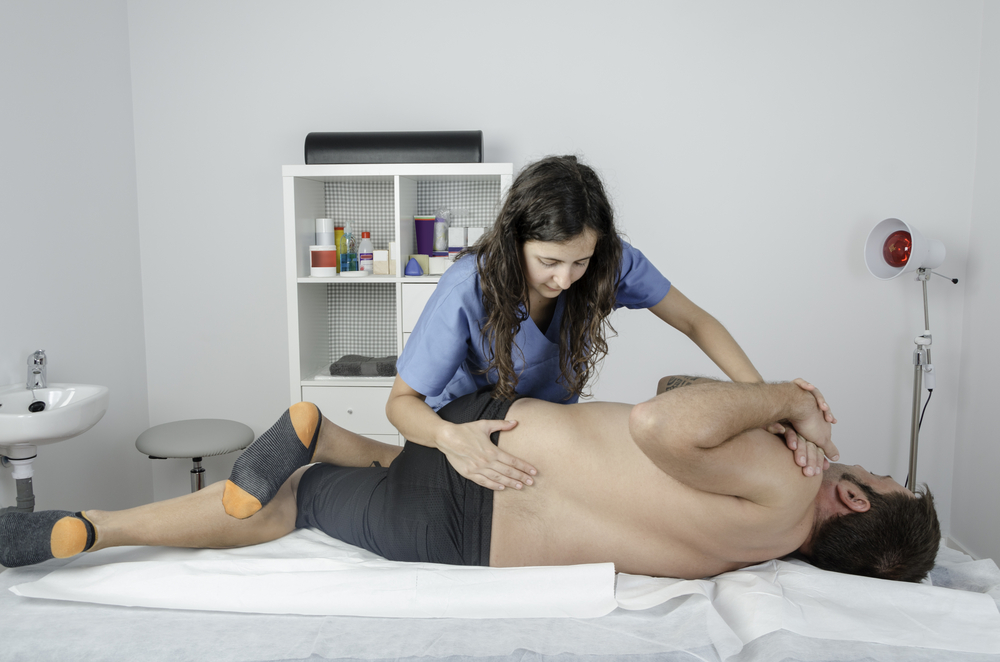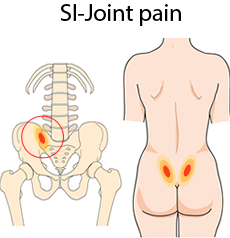Lower back pain most commonly caused by problems with SI-joint.
More than 26 million Americans experience frequent back pain. In a lot of cases, the sacro-iliacal joint – in short SI-joint – is the big offender. This is also called ‘SI-syndrome’. Sometimes the pain may radiate to the buttock, groin or leg. Let’s take a close up look at this troublesome SI-joint in the lower back. Here are just a few questions we will answer: What kind of joint is it exactly? What is its function? And why does it sometimes cause so many problems?
What is the SI-joint?
Your body is equipped with two SI-joints, which make the connection between the spinal column and bones of the legs. This region is called the pelvis. These joints can be seen from the outside. They are two small pits on both sides of the lower back at about the level you wear your belt. The SI-joints transfer the weight of your upper body to your hips and legs. These joints are continuously under high pressure. Because these joints are very rigid, they provide solidity to the cervical spine and pelvis. It was long disputed whether these ‘rigid joints’ were indeed real joints. There appears to be some movement between the bony pieces – sacrum and pelvis – to which the SI-joints are attached. It can slide 2-3 mm and turn 2-3 degrees.
How do problems with the SI-joints arise?
Any type of fall or slide landing on your buttocks is one of the main causes of lower back pain. Also, when you make an unbalanced step, the ligaments surrounding the joint may become damaged. Furthermore, pregnancy may play a role in the development of SI-complaints. This is also the case when one leg is shorter than the other. Another cause may be a ‘block’ of the SI-joint. It is then stuck and cannot make its minimal movements. Moreover, lower back pain can be caused by increased mobility of these joints for instance in the case of pelvic instability. In addition, arthritis can cause inflammation and wear in the SI-joints. People who suffer from Bekhterev’s disease may experience inflammation in the SI-joints. There is no evident cause to be found in 35% of the cases. The pain in the SI-joint may then have occurred spontaneously.
What are the symptoms accompanying complaints of the SI-joints?
The most frequent complaints are pain in the lower back and buttock region. This may occur on one or both sides. The pain may radiate all the way down even to the foot. SI-joint issues are sometimes confused with hernia, because this condition presents exactly the same symptom. Also, a painful feeling may occur in the groin area. Muscle spasms also occur in people with SI-complaints. Walking, sitting and bending can all cause pain. Sitting can be especially problematic. People with SI-pain often need to keep one buttock tilted up when sitting on a chair, which a very uncomfortable position.
How are problems with the SI-joints diagnosed?
The doctor can diagnose problems with the SI-joints when the following five symptoms are present:
1. The pain must be present around the SI-joint.
2. The SI-joint is sensitive when being percussed.
3. The pain increases upon repeatedly sitting and rising.
4. The pain will be present in many different positions.
5. The pain will radiate from the buttock region to the legs.

The physical therapist or can help you with your exercises
How are SI-complaints treated?
Your doctor will usually refer you to a or physical therapist. In most cases, the physical therapist will advise you to give the back rest for a few weeks. This helps to decrease inflammation and muscle spasms. In addition, he can give you exercises to strengthen the torso, buttock and thigh muscles and make them more flexible, which accelerates recovery. Moreover, he will work with you on mobilizing exercises to end the SI-joint blockage. When the complaints are caused by too much flexibility of one or both SI-joints, wearing a special sacro-iliacal brace may help to stabilize the joints. The brace needs to be tightened around the hips and helps to ease the pain. Furthermore, the doctor may prescribe paracetamol, to help the pain, or an anti-inflammatory medication to help with the pain and the inflammation.
Surgery: blocking the SI-joint
After heavy and persisting complaints it surgery can be performed. When an SI-block occures, the nerves that run to the joint are interrupted. At pharmacological treatment, the nerves that run along the SI-joint are shortly anesthetized. Thereafter, an anti-inflammatory drug is injected, which decreases the irritation and pain of the SI-joint. When this treatment has little or no result, an RF-treatment can be initiated. The doctor inserts a needle in the SI-joint. Consequently, this is connected to a device delivering Radio Frequent current. This way, the needle is heated for a short period of time, which causes a different pain conduction making the complaints to disappear for a longer period of time.

Share this page
Tweet

Download for free the booklet ‘Moving without pain’ with a retail value of $6.75 / £4.95.
Any questions? Please feel free to contact us. Contact us.






